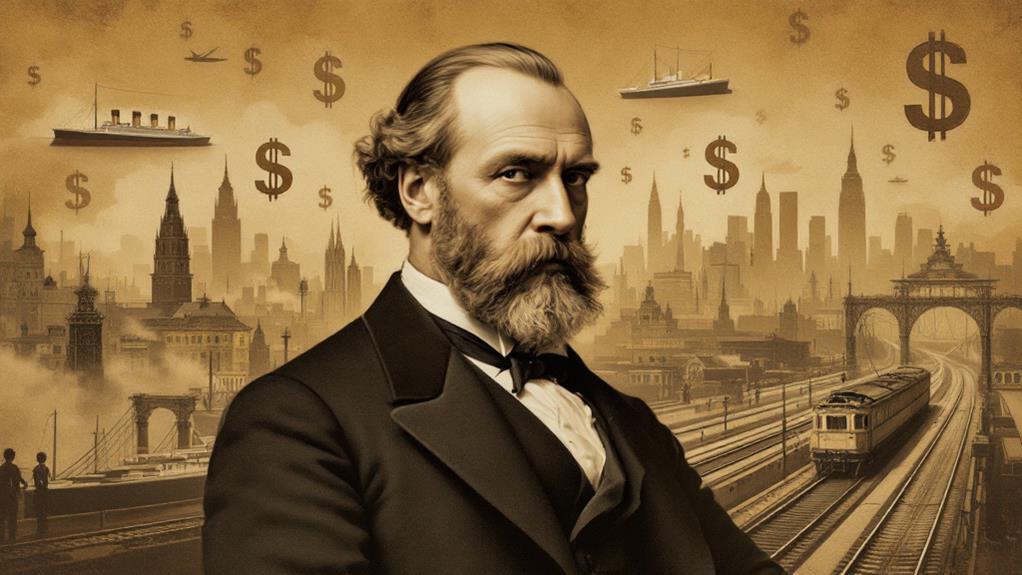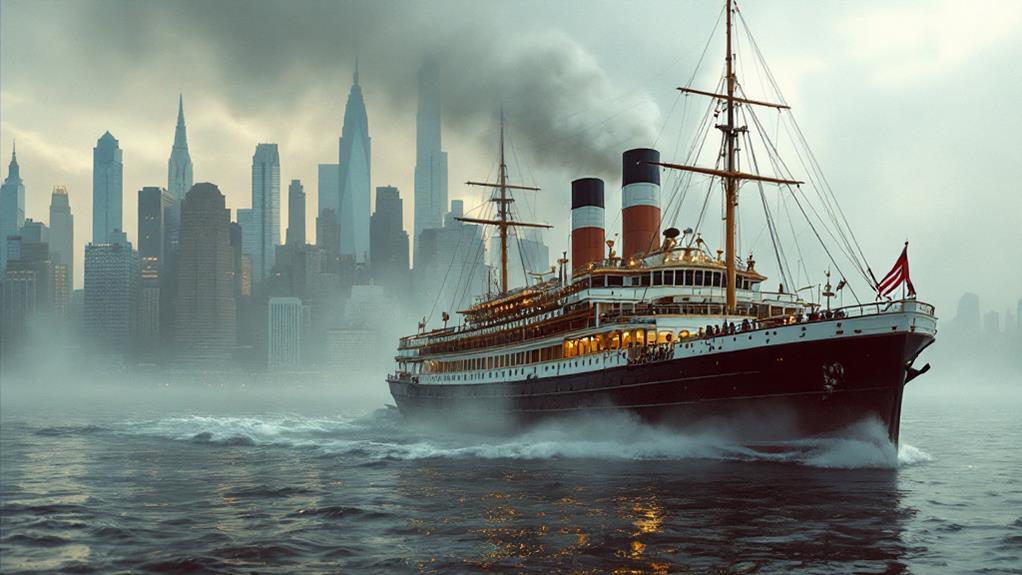Who Was Cornelius Vanderbilt? A Look at His Legacy

You're exploring Cornelius Vanderbilt, a pioneering force behind America's transportation revolution. Born into poverty in 1794, he left school at 11 and started a successful ferry business at 16. He dominated steamboats by drastically cutting fares and later built a railroad empire, including the New York Central Railroad. His ventures enhanced American commerce and infrastructure during the Gilded Era. Besides amassing immense wealth, Vanderbilt donated $1 million to found Vanderbilt University, leaving a significant philanthropic legacy. His strategic innovations and contributions shaped modern transportation and education. There's more to uncover about his intriguing and transformative expedition.
Early Life and Beginnings
In the early years of Cornelius Vanderbilt's life, he displayed an entrepreneurial spirit that would define his future success. Born on May 27, 1794, in Port Richmond, Staten Island, to a family of impoverished farmers, he faced financial challenges from a young period. Despite leaving school at 11, he didn't let his circumstances deter him. By 16, he had borrowed $100 from his mother, purchased a periauger, and launched his business career, ferrying passengers and freight across the waters of New York.
Vanderbilt's early ventures quickly earned him a reputation for reliability and competitive pricing. This was no small feat in a lively port city where competition was fierce. During the War of 1812, his operations expanded as he began supplying government outposts, demonstrating his ability to adapt and seize opportunities. This period was vital in laying the groundwork for his later adventures.
Rise in the Steamboat Industry
Rarely does one encounter a story as compelling as Cornelius Vanderbilt's rise in the steamboat industry. Starting in 1817, Vanderbilt worked as a ferry captain for Thomas Gibbons, where he honed his skills in operations and cutthroat competition. This experience laid the groundwork for his future success. By 1829, Vanderbilt launched his own steamship company, transforming Hudson River traffic. His strategy was simple yet effective: drastically undercut current fares. While others charged $4, Vanderbilt offered rides for as low as $1, effectively dismantling the monopoly that Fulton and Livingston held over the steamboat industry.
Vanderbilt's aggressive fare tactics didn't just lower costs; they boosted his entire business. He improved luxury services, attracting more passengers to his fleet. By the mid-1840s, he owned over 100 steamboats and became a millionaire by 1846, leveraging fierce fare wars and strategic market positioning. His savvy didn't stop there. Through ventures like the Accessory Transit Company, Vanderbilt capitalized further during the California Gold Rush, earning over $1 million annually. His dominance in the steamboat industry was more than just financial success; it was a complete transformation fueled by innovation and competition.
The California Gold Rush Impact

The California Gold Rush of 1848 created a frenzy for faster routes to the goldfields, and Cornelius Vanderbilt seized this opportunity with precision. He founded the Accessory Transit Company in 1847, a year ahead of the Gold Rush, anticipating the demand for efficient transportation to California. By offering a route from New York to San Francisco via Nicaragua, Vanderbilt's steamship services drastically cut travel time to just 35 days. This was a significant improvement over the arduous and expensive clipper ship voyages that took months.
Vanderbilt's groundbreaking approach didn't just shorten travel time; it also showcased his prowess as an entrepreneur. His aggressive tactics in the transportation industry forced competitors to pay him a staggering $40,000 monthly just to keep their operations afloat without directly competing against him. This strategy not only cemented his dominance but also contributed to his growing wealth.
Building a Railroad Empire
With visionary foresight, Cornelius Vanderbilt turned his attention to railroads in the 1850s, recognizing the potential for a new transportation empire. He acquired significant stock in the New York and Harlem Railroad, eventually becoming its president in 1865. Vanderbilt's strategic moves didn't stop there; he merged the Hudson River Railroad with the New York Central Railroad in 1869, forming a formidable transportation network valued at $90 million. This bold merger positioned him as a leading force in the railroad industry.
Vanderbilt's ambitions extended further when he acquired the Lake Shore and Michigan Southern Railway by 1873, establishing the primary rail service connecting New York City to Chicago. This expansion not only improved his railroad empire but solidified his status among the wealthiest individuals of his time. His investments were essential in constructing the Grand Central Depot, which opened in 1871, providing critical jobs during the economic downturn of the Panic of 1873.
At his death in 1877, Vanderbilt's railroad empire was worth a staggering $105 million. His legacy in the railroads transformed American transportation and laid the foundation for modern infrastructure.
- Merging strategic railroads increased connectivity.
- Investments created significant jobs during economic hardship.
- His fortune underscored his business acumen.
Influence on American Transportation

Cornelius Vanderbilt frequently demonstrated his knack for reshaping industries, and his influence on American transportation was no exception. He began by transforming the steamboat industry, operating over 100 vessels by the mid-1840s. His aggressive tactics and reduced fares broke the Fulton and Livingston monopoly, making travel more accessible. You'd see him using his Accessory Transit Company during the California Gold Rush to connect New York and San Francisco, raking in over $1 million annually. His success was so formidable that rivals paid him to halt operations.
Vanderbilt's shift to railroads marked another leap in transportation. He consolidated key lines into the New York Central and Hudson River Railroad, creating a transportation network that redefined travel. This consolidation didn't just streamline operations; it also set the stage for modern corporate practices in the Gilded Era. By constructing the Grand Central Depot in Manhattan, he provided thousands of jobs during an economic downturn, influencing the economic landscape profoundly.
Philanthropy and University Legacy
Despite his reputation as a ruthless industrialist, Vanderbilt had a softer side that manifested through his philanthropic efforts. In 1873, Cornelius Vanderbilt made a landmark donation of $1 million to establish Vanderbilt University in Nashville, Tennessee. This substantial gift laid the foundation for an institution that has become synonymous with academic excellence and groundbreaking research programs. While Vanderbilt didn't engage extensively in philanthropy like Carnegie or Rockefeller, his singular act of generosity in higher education has left an indelible mark.
When you think about his legacy, consider these points:
- Lasting Impact: Vanderbilt University stands as a symbol of the enduring value of investing in education.
- Family Tradition: Vanderbilt's descendants, including Gloria Vanderbilt and Anderson Cooper, have continued the family's commitment to charitable causes.
- Strategic Giving: His choice to focus on one major donation illustrates the power of targeted philanthropy.
The Vanderbilt family, one of the wealthiest and most prominent in the United States, further cemented his philanthropic legacy through their own endeavors. Their collective contributions have highlighted the importance of giving back, setting a standard for responsible stewardship and community involvement. In sum, Cornelius Vanderbilt's vision for higher education continues to influence generations, underscoring his complex inheritance.
Vanderbilt's Enduring Impact

Cornelius Vanderbilt's transformative impact on American infrastructure and transportation takes center stage when examining his enduring legacy. By innovating the transportation industry with his shift from steamboats to railroads, Vanderbilt considerably improved travel and commerce efficiency in the 19th century. His strategic innovations made rail travel more accessible, particularly influencing economic growth in the Midwestern U.S. during the Gilded Era.
A crucial moment in Vanderbilt's career was the construction of Grand Central Depot in 1871, which later evolved into the iconic Grand Central Terminal. This hub transformed urban infrastructure in New York City and remains a symbol of his vision. His competitive pricing strategies in both steamboat and railroad operations further cemented his status as one of the wealthiest individuals of his time.
Beyond transportation, Vanderbilt's philanthropic legacy shines through his substantial donation of $1 million to establish Vanderbilt University in Nashville in 1873. This contribution highlights his commitment to education and higher learning. By the time of his death in 1877, Vanderbilt's estate value reached approximately $105 million. This fortune laid the foundation for the Vanderbilt family's continued prominence in American society and business.




